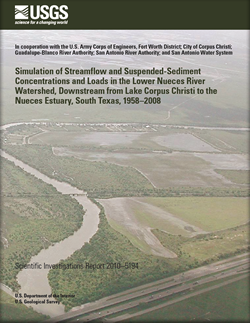Scientific Investigations Report 2010–5194

The U.S. Geological Survey (USGS), in cooperation with the U.S. Army Corps of Engineers–Fort Worth District, City of Corpus Christi, Guadalupe-Blanco River Authority, San Antonio River Authority, and San Antonio Water System, developed, calibrated, and tested a Hydrological Simulation Program—FORTRAN (HSPF) watershed model to simulate streamflow and suspended-sediment concentrations and loads during 1958–2008 in the lower Nueces River watershed, downstream from Lake Corpus Christi to the Nueces Estuary in South Texas. Data available to simulate suspended-sediment concentrations and loads consisted of historical sediment data collected during 1942–82 in the study area and suspended-sediment concentration data collected periodically by the USGS during 2006–07 at three USGS streamflow-gaging stations, Nueces River near Mathis, Nueces River at Bluntzer, and Nueces River at Calallen. The Nueces River near Mathis station is downstream from Wesley E. Seale Dam, completed in 1958 to impound Lake Corpus Christi. Suspended-sediment data collected before and after completion of Wesley E. Seale Dam provide insights to the effects of the dam and reservoir on suspended-sediment loads transported by the lower Nueces River from downstream of the dam to the Nueces Estuary. Annual suspended-sediment loads at a site near the Nueces River at Mathis station were considerably lower, for a given annual mean discharge, after the dam was completed than before the dam was completed. Most of the suspended sediment transported by the Nueces River downstream from Wesley E. Seale Dam occurred during high-flow releases from the dam or during floods. During October 1964–September 1971, about 532,000 tons of suspended sediment were transported by the Nueces River near Mathis. Of this amount, about 473,000 tons, or about 89 percent, were transported by large runoff events (mean streamflow exceeding 1,000 cubic feet per second). To develop the watershed model to simulate suspended-sediment concentrations and loads in the lower Nueces River watershed during 1958–2008, streamflow simulations were calibrated and tested with available data for 2001–08 from the Nueces River at Bluntzer and Nueces River at Calallen stations. Streamflow data from the Nueces River near Mathis station were used as input to the model at the upstream boundary of the model. Simulated streamflow volumes for the Bluntzer and Calallen stations showed good agreement (within 6 percent) with measured streamflow volumes. The HSPF model was calibrated to simulate suspended sediment using suspended-sediment data collected at the Mathis, Bluntzer, and Calallen stations during 2006–07. The calibrated watershed model was used to estimate streamflow and suspended-sediment loads for 1958–2008, including loads transported to the Nueces Estuary. During 1958–2008, on average, an estimated 307 tons per day of suspended sediment were delivered to the lower Nueces River; an estimated 297 tons per day were delivered to the estuary. The annual suspended-sediment load was highly variable, depending on the occurrence of storm events and high streamflows. During 1958–2008, the annual total sediment loads to the estuary varied from an estimated 3.8 to 2,490 tons per day. On average, 117 tons per day, or about 38 percent of the estimated annual suspended-sediment contribution, originated from cropland in the study watershed. Releases from Lake Corpus Christi delivered an estimated 98 tons per day of suspended sediment or about 32 percent of the 307 tons per day estimated to have been delivered to the lower Nueces River. Erosion of stream-channel bed and banks accounted for 55 tons per day or about 18 percent of the estimated total suspended-sediment load. All other land categories, except cropland, accounted for an estimated 37 tons per day, or about 12 percent of the total. An estimated 9.6 tons per day of suspended sediment or about 3 percent of the suspended-sediment load delivered to the lower Nueces River were removed by water withdrawals before reaching the Nueces Estuary. |
First posted October 26, 2010 For additional information contact: Part or all of this report is presented in Portable Document Format (PDF); the latest version of Adobe Reader or similar software is required to view it. Download the latest version of Adobe Reader, free of charge. |
Ockerman, D.J., and Heitmuller, F.T., 2010, Simulation of streamflow and suspended-sediment concentrations and loads in the lower Nueces River watershed, downstream from Lake Corpus Christi to the Nueces Estuary, South Texas, 1958–2008: U.S. Geological Survey Scientific Investigations Report 2010–5194, 50 p.
Abstract
Introduction
Suspended-Sediment Concentrations and Loads of the Lower Nueces River
Simulation of Streamflow and Suspended-Sediment Concentrations and Loads of the Lower Nueces River
Summary
References
Appendix 1. Hydrological Simulation Program—FORTRAN (HSPF) Parameters Used to Simulate Hydrologic and Sediment Processes in the Lower Nueces River Watershed, South Texas